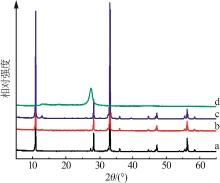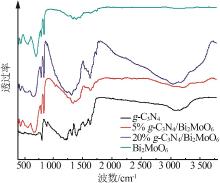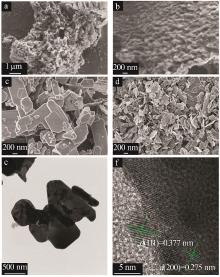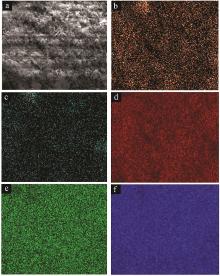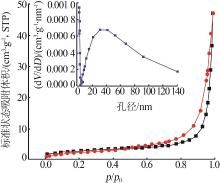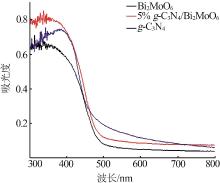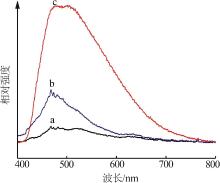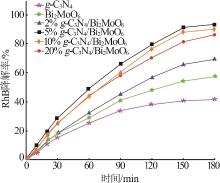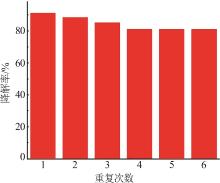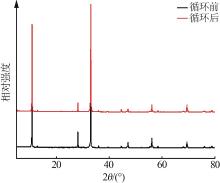Inorganic Chemicals Industry ›› 2022, Vol. 54 ›› Issue (11): 131-136.doi: 10.19964/j.issn.1006-4990.2022-0038
• Catalytic Materials • Previous Articles Next Articles
Study on preparation and properties of g-C3N4/Bi2MoO6 composite photocatalysts
CHU Jiahuan( ),TANG Jiacheng,ZHU Yuan,ZHANG Jin(
),TANG Jiacheng,ZHU Yuan,ZHANG Jin( )
)
- School of Environmental Science,Nanjing Xiaozhuang University,Nanjing 211171,China
-
Received:2022-02-12Online:2022-11-10Published:2022-11-23 -
Contact:ZHANG Jin E-mail:978970817@qq.com;jzmary@163.com
CLC Number:
Cite this article
CHU Jiahuan,TANG Jiacheng,ZHU Yuan,ZHANG Jin. Study on preparation and properties of g-C3N4/Bi2MoO6 composite photocatalysts[J]. Inorganic Chemicals Industry, 2022, 54(11): 131-136.
share this article
| 1 | CAREY J H, LAWRENCE J, TOSINE H M.Photodechlorination of PCB′s in the presence of titanium dioxide in aqueous suspensions[J].Bulletin of Environmental Contamination and Toxicology,1976,16(6):697-701. |
| 2 | JATAV S, LIU Junying, HERBER M, et al.Facet engineering of bismuth molybdate via confined growth in a nanoscale template toward water remediation[J].ACS Applied Materials & Interfaces,2021,13(16):18713-18723. |
| 3 |
LI Gui, YANG Weiyi, GAO Shuang, et al.Creation of rich oxygen vacancies in bismuth molybdate nanosheets to boost the photocatalytic nitrogen fixation performance under visible light illuminati-on[J].Chemical Engineering Journal,2021,404.Doi:10.1016/j.cej.2020.127115.
doi: 10.1016/j.cej.2020.127115 |
| 4 |
KUMAR R, SUDHAIK A, RAIZADA P, et al.An overview on bismuth molybdate based photocatalytic systems:Controlled morphology and enhancement strategies for photocatalytic water purification[J].Journal of Environmental Chemical Engineering,2020,8(5).Doi:10.1016/j.jece.2020.104291.
doi: 10.1016/j.jece.2020.104291 |
| 5 | 赵依凡,毛琦云,翟晓雅,等.钼酸铋光催化剂的结构缺陷调控[J].化学进展,2021,33(8):1331-1343. |
| ZHAO Yifan, MAO Qiyun, ZHAI Xiaoya, et al.Structural defects regulation of bismuth molybdate photocatalyst[J].Progress in Che-mistry,2021,33(8):1331-1343. | |
| 6 | SAYED M S, MOHAPATRA D, BAYNOSA M L, et al.Three-dimensional core-shell heterostructure of tungsten trioxide/bismuth molybdate/cobalt phosphate for enhanced photoelectrochemical water splitting[J].Journal of Colloid and Interface Science,2021,598: 348-357. |
| 7 | ONG W J, TAN L L, NG Y H, et al.Graphitic carbon nitride(g-C3N4)-based photocatalysts for artificial photosynthesis and environmental remediation:Are we a step closer to achieving sustainability?[J].Chemical Reviews,2016,116(12):7159-7329. |
| 8 | 陈建军,乔岩,刘梓娴,等.金负载多孔g-C3N4纳米片制备及可见光催化产氢性能[J].无机盐工业,2022,54(3):132-136. |
| CHEN Jianjun, QIAO Yan, LIU Zixian, et al.Preparation of Au-supported porous g-C3N4 nanosheets for photocatalytic H2 evolution performance under visible-light[J].Inorganic Chemicals Industry,2022,54(3):132-136. | |
| 9 | 杨莉,李润泽,张黎,等.花簇状g-C3N4/Bi2MoO6微球的制备及其光催化降解模拟染料废水[J].精细化工,2021,38(5):1030-1037. |
| YANG Li, LI Runze, ZHANG Li, et al.Preparation of flower-like g-C3N4/Bi2MoO6 microspheres and their photocatalytic degradation of simulated dye wastewater[J].Fine Chemicals,2021,38(5):1030-1037. | |
| 10 | RAIZADA P, KUMAR A, SINGH P.Graphitic carbon nitride-based new advanced materials for photocatalytic applications[J].Current Analytical Chemistry,2021,17(2):150-165. |
| 11 | 孟亚楚,李育珍,张艾明,等.Bi2MoO6/g-C3N4 Z型异质结的合成及其光催化性能的研究[J].太原理工大学学报,2020,51(2):253-258. |
| MENG Yachu, LI Yuzhen, ZHANG Aiming, et al.Synthesis and photocatalytic activity of Bi2MoO6/g-C3N4 Z-scheme heterojuncti-on[J].Journal of Taiyuan University of Technology,2020,51(2):253-258. | |
| 12 | 王秀.类石墨相氮化碳的改性及其在水污染治理中的应用[D].武汉:华中科技大学,2017. |
| WANG Xiu.The modification of g-C3N4 and their application in wastewater treatment[D].Wuhan:Huazhong University of Science and Technology,2017. | |
| 13 | 王书红,刘新,孔斌,等.CeO2/Bi2MoO6纳米复合材料的制备及其增强光催化降解性能研究[J].有色金属科学与工程,2019,10(2):68-76. |
| WANG Shuhong, LIU Xin, KONG Bin, et al.Synthesis of CeO2/Bi2MoO6 nanocomposites and their enhanced photocatalytic degradation performance[J].Nonferrous Metals Science and Engineering,2019,10(2):68-76. | |
| 14 | YAN Tao, YAN Qing, WANG Xiaodong, et al.Facile fabrication of heterostructured g-C₃N₄/Bi₂MoO₆ microspheres with highly efficient activity under visible light irradiation[J].Dalton Transactions:Cambridge,England,2015,44(4):1601-1611. |
| 15 | LI Haiping, LIU Jingyi, HOU Wanguo, et al.Synthesis and characterization of g-C3N4/Bi2MoO6 heterojunctions with enhanced visible light photocatalytic activity[J].Applied Catalysis B:Environmental,2014,160/161: 89-97. |
| 16 | 周杰,管国锋,朱蓓蓓,等. g-C3N4/ZnO复合材料的制备、表征及可见光催化性能[J].精细化工,2018,35(2):228-232,266. |
| ZHOU Jie, GUAN Guofeng, ZHU Beibei, et al.Preparation,characterization and photocatalytic activities of g-C3N4/ZnO composites[J].Fine Chemicals,2018,35(2):228-232,266. | |
| 17 | CHEN Daimei, HAO Qiang, WANG Zhihong, et al.Influence of phase structure and morphology on the photocatalytic activity of bismuth molybdates[J].CrystEngComm,2016,18(11):1976-1986. |
| 18 | LI Shijie, HU Shiwei, JIANG Wei, et al.Facile synthesis of cerium oxide nanoparticles decorated flower-like bismuth molybdate for enhanced photocatalytic activity toward organic pollutant degradation[J].Journal of Colloid and Interface Science,2018,530: 171-178. |
| 19 | 熊芸,陈新,张静,等.BiOBr/UiO-66-(COOH)2复合材料制备及光催化性能研究[J].无机盐工业,2021,53(12):150-155. |
| XIONG Yun, CHEN Xin, ZHANG Jing, et al.Preparation and photocatalytic properties of BiOBr/UiO-66-(COOH)2 composite materials[J].Inorganic Chemicals Industry,2021,53(12):150-155. | |
| 20 | DARKHOSH F, LASHANIZADEGAN M, MAHJOUB A R, et al.One pot synthesis of CuFeO2 @ expanding perlite as a novel efficient floating catalyst for rapid degradation of methylene blue under visible light illumination[J].Solid State Sciences,2019,91: 61-72. |
| 21 | HU Yongpan, HUANG Wei, WANG Hongshuai, et al.Metal-free photocatalytic hydrogenation using covalent triazine polymers[J].Angewandte Chemie,2020,132(34):14484-14488. |
| 22 | LI Ning, GAO Hang, WANG Xin, et al.Novel indirect Z-scheme g-C3N4/Bi2MoO6/Bi hollow microsphere heterojunctions with SPR-promoted visible absorption and highly enhanced photocatalytic performance[J].Chinese Journal of Catalysis,2020,41(3):426-434. |
| 23 | XIAO Ke, HUANG Hongwei, TIAN Na, et al.Mixed-calcination synthesis of Bi2MoO6/g-C3N4 heterojunction with enhanced visi-ble-light-responsive photoreactivity for RhB degradation and photocurrent generation[J].Materials Research Bulletin,2016,83: 172-178. |
| 24 | 胡俊俊,丁同悦,陈奕桦,等.Ag3PO4/g-C3N4复合材料的制备及其光催化性能[J].精细化工,2021,38(3):483-488. |
| HU Junjun, DING Tongyue, CHEN Yihua, et al.Preparation and photocatalytic application of Ag3PO4/g-C3N4 composites[J].Fine Chemicals,2021,38(3):483-488. |
| [1] | TANG Bei. Preparation of ZnO/g-C3N4 heterojunction photocatalytic material and its degradation of pyridine [J]. Inorganic Chemicals Industry, 2024, 56(4): 133-142. |
| [2] | HUANG Jianan, LU Xiaoyu, WANG Mitang. Effect of Ba-La co-doping on degradation of methylene blue dye by TaON [J]. Inorganic Chemicals Industry, 2024, 56(2): 146-151. |
| [3] | YANG Bo, LIANG Zhiyan, LIU Wenyuan, CAO Jiazhen, LIU Xinyue, XING Mingyang. Research progress of application of molybdenum-based catalytic materials for water pollution control [J]. Inorganic Chemicals Industry, 2023, 55(8): 1-12. |
| [4] | YU Hongchao, ZHANG Mengmeng, JIN Tianxiang. Research progress of microstructure and crystal surface effect of Ag3PO4 photocatalysts [J]. Inorganic Chemicals Industry, 2023, 55(8): 13-20. |
| [5] | ZHAO Yan, HAO Xuewei, SHI Hainan, LI Jiahui, LI Keyan, GUO Xinwen. Study on photocatalytic CO2 reduction performance of Cu-doped TiO2/PCN heterojunction [J]. Inorganic Chemicals Industry, 2023, 55(8): 21-27. |
| [6] | SUN Haijie, CHENG Yuan, TIAN Yuan, LIU Hongyan, CHEN Zhihao. Preparation of BiOI/g-C3N4 catalyst and its photocatalytic degradation performance of Rhodamine B [J]. Inorganic Chemicals Industry, 2023, 55(8): 36-44. |
| [7] | SONG Zhijia, WANG Suisui, KUANG Qin. Hollow Cu-doped TiO2 for enhancing photocatalytic CO2 reduction performance [J]. Inorganic Chemicals Industry, 2023, 55(8): 45-50. |
| [8] | LAN Yinghua, CHEN Yanmei, MA Ruixiao, ZHANG Yanhui. Preparation and photocatalytic performance of Ce-Ti oxide-attapulgite composites [J]. Inorganic Chemicals Industry, 2023, 55(4): 133-140. |
| [9] | CHEN Zhangxu, FU Minglian, ZHU Danchen, ZHENG Bingyun. Preparation of carbon/graphite carbon nitride composites and their methylene blue removal performance [J]. Inorganic Chemicals Industry, 2023, 55(3): 134-139. |
| [10] | QIU Xiaokui, ZHANG Ruofan, WANG Xiaoyan, WANG Hailong, ZHANG Qixue, WAN Chao, XU Lixin. Research on bamboo shavings carbon supported ruthenium catalysts for hydrogen generation from photocatalytic hydrolysis of ammonia borane [J]. Inorganic Chemicals Industry, 2023, 55(10): 153-158. |
| [11] | ZHANG Zhe,LIAO Mingyu,CHEN Ming,YU Shanshan,ZHOU Kangdi,LI Jiachun,ZHANG Linfeng,WU Huadong,GUO Jia. Application of CeO2-ZnO/KIT-6 catalyst in photocatalytic adsorption desulfurization [J]. Inorganic Chemicals Industry, 2022, 54(9): 143-149. |
| [12] | TONG Haijuan,LI Siqi,FAN Fangfang,ZUO Weiyuan,SHI Bingfang. Facile synthesis of bismuth oxychloride and its photocatalytic degradation performance of p-nitrophenol [J]. Inorganic Chemicals Industry, 2022, 54(9): 157-162. |
| [13] | YANG Wenbo,WU Pan,HE Jian,LIU Changjun,JIANG Wei. Study on effect of heating rate on structure-activity of g-C3N4 photocatalyst by pyrolysis of urea [J]. Inorganic Chemicals Industry, 2022, 54(4): 169-174. |
| [14] | JI Chang,WANG Guosheng. Degradation of berberine by visible light over Ag3PO4 /g-C3N4 heterojunction catalyst [J]. Inorganic Chemicals Industry, 2022, 54(4): 175-180. |
| [15] | LIANG Fang,SHI Fanian. Research progress on synthesis of bismuth based bimetallic photocatalyst and degradation of organic pollutants [J]. Inorganic Chemicals Industry, 2022, 54(4): 61-68. |
| Viewed | ||||||
|
Full text |
|
|||||
|
Abstract |
|
|||||
|
||
